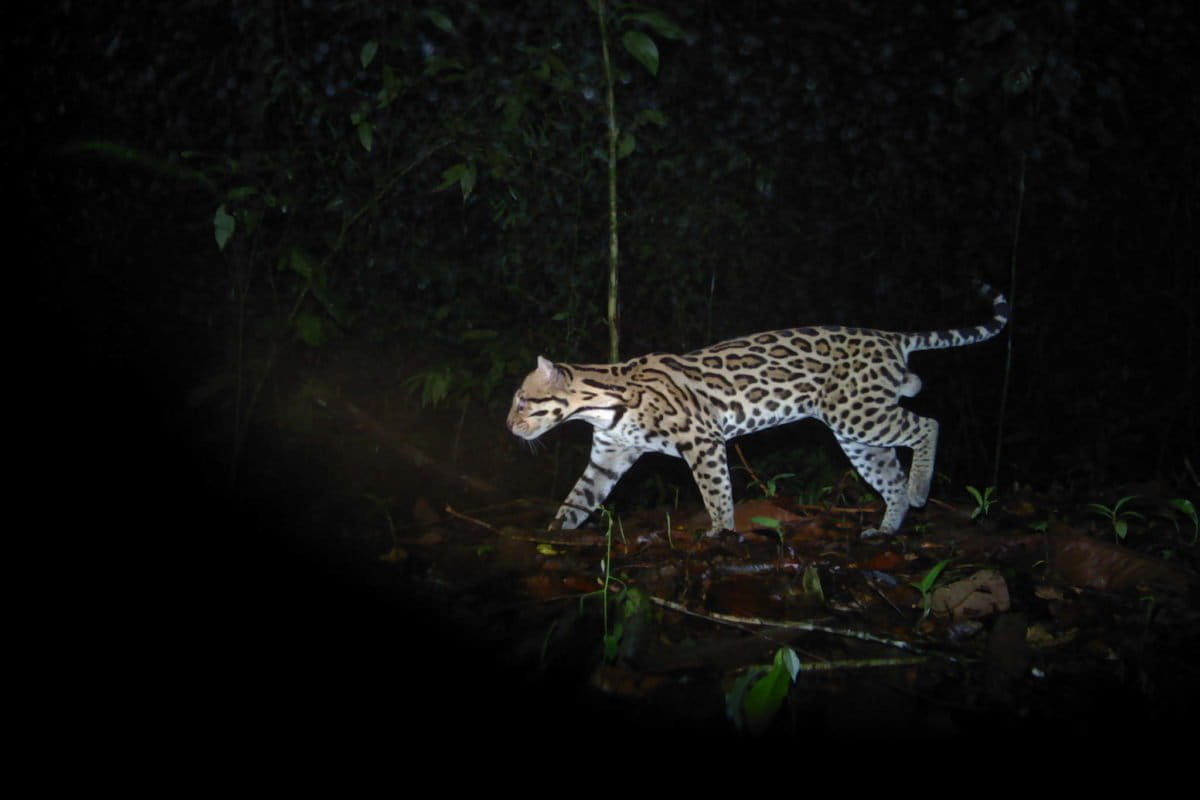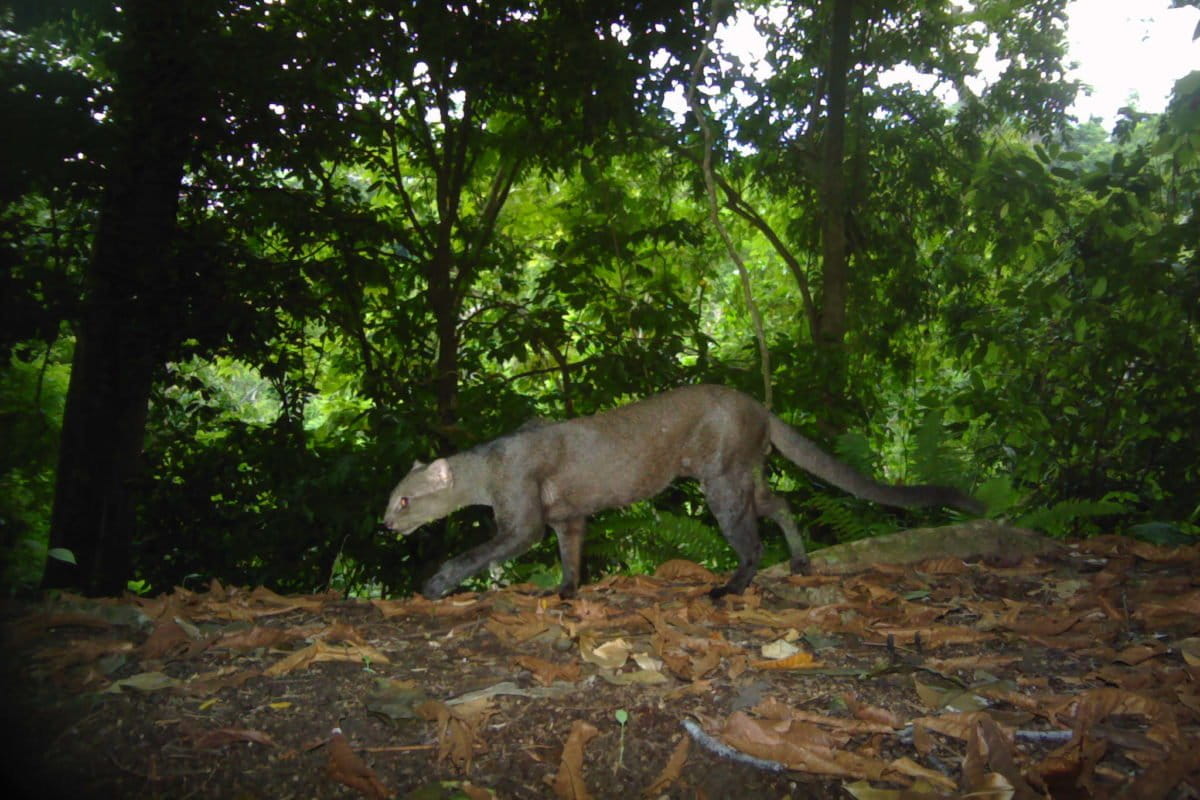- The largest-ever camera trap study in Central America, on Costa Rica’s Osa Peninsula, has revealed how human disturbance affects where animals live and how they’re grouped.
- Protected areas and healthy forests held a greater diversity of animals as well as larger species like tapirs, jaguars and pumas, while places with more human activity had fewer species, which tended to be smaller, more common animals like opossums and agoutis.
- The camera trap study, begun in early 2018, shows many species have recovered completely in the forest reserves around Corcovado National Park, indicating that conservation efforts over the past 30 years have been largely effective.
- Local conservation groups are now focused on creating wilderness corridors so larger species like jaguars can rebound in neighboring forests.
After she collected a set of camera traps from the ridgeline above Corcovado National Park, conservation biologist Eleanor Flatt said that scientists, staff, and tourists all huddled around her computer at the Punta Marenco Lodge to see what images were captured.
Camera traps, remote cameras triggered by motion, can be set off by something as mundane as a leaf blowing in the wind. So, as blurry shots of bushes, fronds, and regularly seen animals appeared, she says, many lost interest — until a puma flashed across the screen.
“Everyone came running back,” Flatt said. “They couldn’t believe it.”

“We all know that rainforest animals can be super secretive and often never seen,” Andy Whitworth, director of the NGO Osa Conservation told Mongabay in a 2018 interview about the camera trap project, “especially some of the most charismatic species, like the cats, and weird and wonderful nocturnal beasts, like the hog-nosed skunk.”
That’s why scientists launched the largest camera trap study in Central America to date. They wanted to learn how human disturbance affects where animals live and how they’re grouped on the Osa Peninsula (a spit of land on Costa Rica’s Pacific side about one-and-a-half times as big as Los Angeles, California).
The Osa Peninsula is noted as an oasis of tropical biodiversity, home to many plants and animals found nowhere else on Earth. It’s one of the last places in Central America to support healthy populations of five wild cats — jaguar, puma, ocelot, margay, and jaguarundi — all of them notoriously elusive to humans.

In February 2018, teams of biologists from several universities and NGOs along with community members installed 240 cameras in a grid across the entire peninsula. Cameras were left in the forest for an average of four months.
After sorting through 13,600 detections of 26 wild mammal and ground bird species they found two distinct communities of animals living in disturbed versus undisturbed areas. Their results are now published in the journal Conservation Biology.

The healthier ecosystems, often areas of the peninsula with the strictest land protections, such as Corcovado National Park, held a greater diversity of animals as well as larger species like tapirs, jaguars, and pumas.
Places with more human activity had fewer species of animals, and those animals were often smaller, more common species like opossums and agoutis. Some of these smaller animals, opossums in particular, were more abundant in disturbed sites than in healthy forests.
Overall, human activity drives large animals out and allows fewer species of smaller creatures like rodents to thrive.
“The results were maybe not surprising,” John Poulsen an associate professor of ecology at Duke University who was not involved in the study said, “but contribute an important data point to a pantropical phenomenon – humans have an immense effect on animal communities, favoring smaller species, and dramatically reducing the distribution and abundance of large species.”




In the 1990s, there were almost no pumas, tapirs or peccaries outside of parks, said Whitworth, a co-author of the study. Now, according to their findings, many species have recovered completely in the forest reserves around Corcovado National Park, and some of those species have even moved out of the peninsula onto the mainland.
“This is the first kind of real study on an ecosystem-wide scale for almost 30 years, and what we actually see is that for many species, there’s a huge recovery.” Whitworth said. “This shows us that the parks and protected areas … they are working.”
The Osa Peninsula has more than 70% forest coverage and lots of protected areas, “but you can still see the effects of disturbance at the edges of the forests,” Juan Vargas Soto, a Costa Rican scientist and Ph.D. candidate at the University of Toronto, told Mongabay. Hunting, roads, and human disturbance are still threats to the forest and the species that live there. “So, it’s very delicate.”
“This study is impressive because of its large scale, both geographically and in terms of the number of species evaluated,” Poulson told Mongabay. “Conducting a study of this magnitude is a logistical nightmare, but they could pull it off because of their strong relationships and collaborations … with local organizations and communities.”

More than a year before the camera traps were put in place, the core group of researchers began talking to landowners and community members across the peninsula to ask for permission to access their land.
“There is a history of conservation in the region, but that doesn’t mean that everyone was on board,” study lead author Vargas-Soto said. “It’s a process.”
The research team worked with existing community organizations and held meetings to explain the goals of the project, train people to use the camera traps, discuss ownership of the data and images, and teach the benefits of wildlife monitoring. Places that rely on ecotourism, for instance, see a benefit from using real photos of animals on their property to draw in visitors.
“When you get a big cat on a property, you can just see how the landowner sort of changes inside,” Flatt said. “They become more proud of their property.” And sometimes, she and Whitworth both said, this changes a landowner’s mind about conservation.


Now, Osa Conservation and others are focused on expanding this recovery by creating and protecting wilderness corridors, akin to forested highways where jaguars and other roving species can roam and grow. Osa Conservation has been running camera traps along highways to try to identify suitable areas to install overpasses or underpasses where wildlife can cross safely. They are also engaged in forest restoration along these corridors.
“There are still challenges for those big apex species that need a lot of room, but what kind of conservation story doesn’t have its challenge?” Whitworth said. “I do think it’s very rare that we see this kind of progress in a conservation story.”
Citation:
Vargas Soto, J. S., Beirne, C., Whitworth, A., Diaz, J. C. C., Flatt, E., Pillco-Huarcaya, R., … Molnár, P. K. (2021). Human disturbance and shifts in vertebrate community composition in a biodiversity hotspot. Conservation Biology. doi:10.1111/cobi.13813
Banner image of a jaguar in the Osa Peninsula courtesy of Osa Conservation.
Liz Kimbrough is a staff writer for Mongabay. Find her on Twitter @lizkimbrough_
Editor’s note: This story was supported by XPRIZE Rainforest as part of their five-year competition to enhance understanding of the rainforest ecosystem. In respect to Mongabay’s policy on editorial independence, XPRIZE Rainforest does not have any right to assign, review, or edit any content published with their support.
FEEDBACK: Use this form to send a message to the author of this post. If you want to post a public comment, you can do that at the bottom of the page
